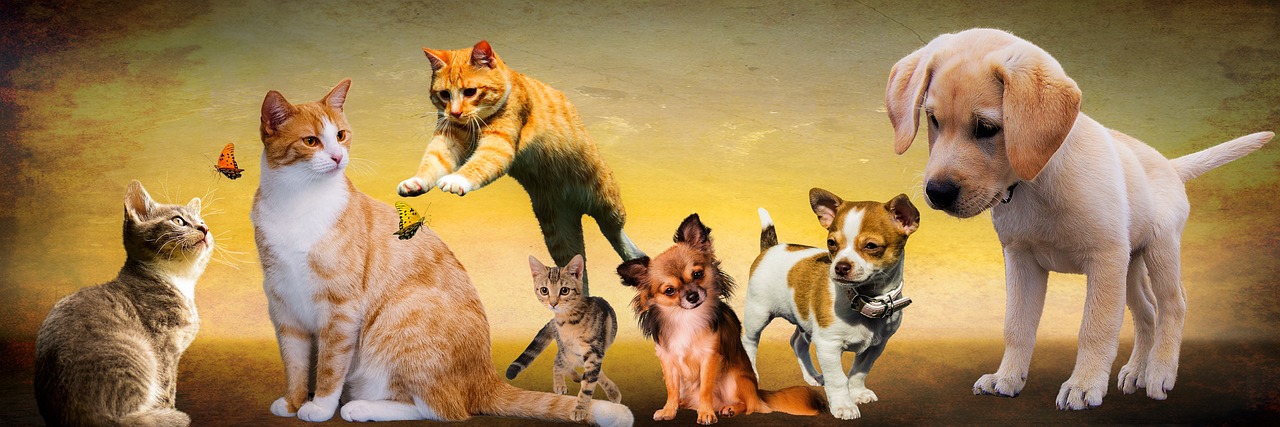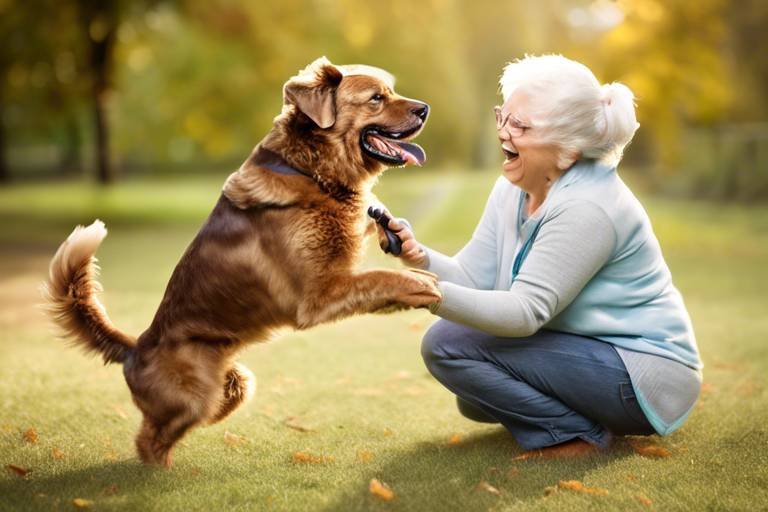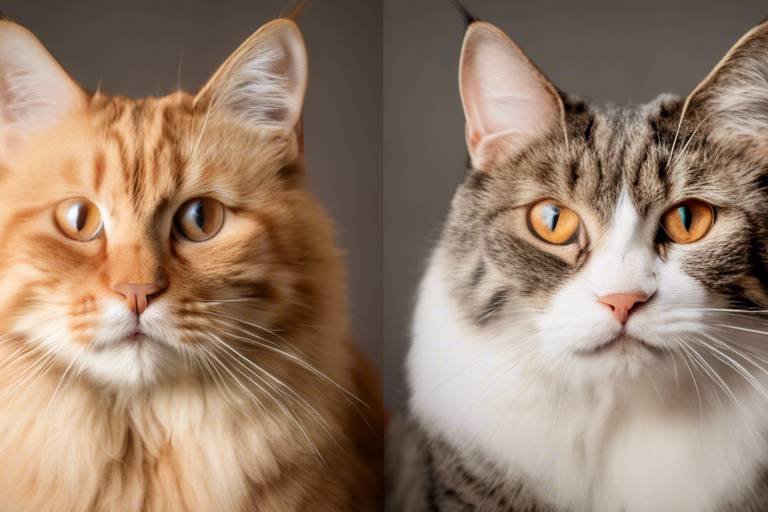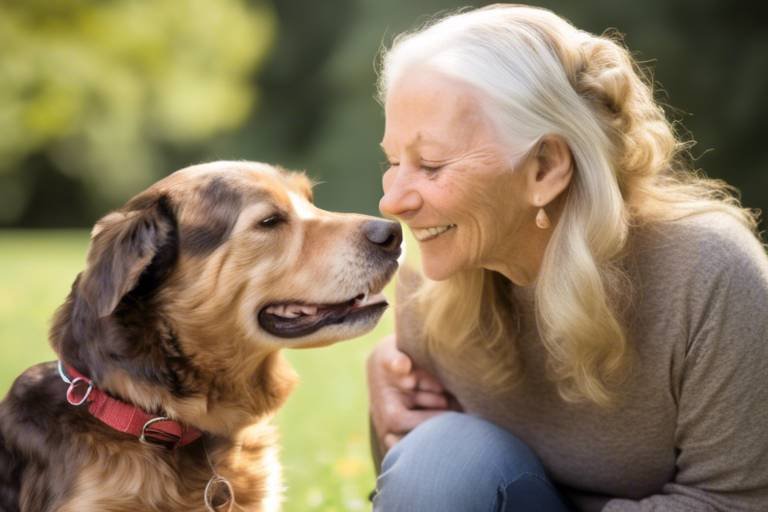Fun Games to Play with Your Senior Dog
As our furry friends age, it becomes increasingly important to keep them both physically and mentally stimulated. Engaging in fun games not only provides entertainment but also strengthens the bond between you and your senior dog. Imagine your dog, tail wagging, eyes sparkling with excitement, as they participate in activities designed just for them. These games can help maintain their mobility, cognitive function, and overall happiness during their golden years. So, let’s dive into some enjoyable activities that will keep your senior dog active and engaged!
Puzzle toys are an excellent way to challenge your senior dog's mind. They come in various shapes and sizes, designed to stimulate your dog's cognitive abilities while keeping them entertained. These toys require your dog to think critically and solve problems, which is essential for their mental health. By engaging with these toys, your dog can reduce feelings of boredom and anxiety, making them feel more fulfilled. You can fill them with treats or kibble, and watch as your dog figures out how to get to the goodies inside. It's like a treasure hunt, but with a delicious reward at the end!
Fetch is a classic game that can be tailored to suit the needs of senior dogs. Instead of using hard balls, opt for softer toys that are easy on their teeth and joints. You can adjust the distance to accommodate their energy levels, ensuring they get some light exercise without overexertion. Engaging in this activity not only helps maintain their mobility but also allows them to channel their natural retrieving instincts. Just picture your dog bounding after a plush toy, their excitement palpable as they bring it back to you!
When playing fetch with your senior dog, using soft toys is key. These toys minimize the risk of injury while still allowing your dog to enjoy the thrill of the chase. It’s a safe way to engage their instincts and keep them active. Imagine the joy on their face as they proudly return the toy to you, tail wagging furiously! This simple game can be a delightful way to spend time together, reinforcing your bond.
If the weather isn't cooperating or you have limited space, indoor fetch can be just as exhilarating. You can play in hallways or living rooms, using soft toys to ensure safety. This way, your dog can enjoy the game without the risk of slipping or getting hurt. Just make sure to clear the area of any obstacles that could pose a hazard. The thrill of the game can still be felt, even in a smaller space!
Outdoor fetch offers more freedom and space for your dog to run and play. However, it's essential to monitor their energy levels closely. You wouldn’t want to tire them out too quickly, so providing breaks is crucial. Think of it as a leisurely stroll in the park, where your dog can explore, sniff, and enjoy their surroundings while still engaging in a fun game. Always keep an eye on their pace and be ready to call it a day when they show signs of fatigue.
Hide and seek is another fantastic game that not only entertains but also encourages your dog to use their senses. This game can be easily adapted to suit their mobility levels. Start by having your dog sit and stay while you hide somewhere in the house. Then, call them to find you! This game promotes mental engagement and can be a delightful way for your dog to practice their recall skills. Plus, the look on their face when they find you is priceless!
Tug-of-war can be a wonderful bonding experience for you and your senior dog, as long as it’s played gently. Using a soft rope toy allows for safe interaction without the risk of injury. This game can help build your dog's confidence and provide a fun outlet for their energy. Just imagine the playful back-and-forth, with your dog tugging at one end and you at the other, both of you enjoying the thrill of the game!
To ensure that tug-of-war remains a positive experience, it's important to establish clear rules. Teaching your dog to release the toy on command can help maintain control and prevent overstimulation. This way, the game stays fun and engaging without turning into a chaotic free-for-all. Think of it like a dance—there are steps to follow, and when both partners are in sync, it becomes a beautiful performance!
Keeping tug-of-war sessions short is essential for preventing fatigue. Senior dogs can tire more quickly than their younger counterparts, so it’s vital to keep the games engaging yet manageable. This approach not only ensures your dog remains enthusiastic about the activity but also helps maintain their energy levels. Just like a quick burst of fireworks, short, exciting sessions can leave your dog wanting more!
Memory games can be a delightful way to stimulate your senior dog's cognitive abilities. Simple activities like hiding treats around the house or using cups to conceal a treat can sharpen their memory and keep their minds active. As they sniff around trying to find the hidden treasures, you’ll be amazed at how quickly they can recall where they last found a treat! It’s like a fun little brain workout that can keep them sharp as they age.
- What types of toys are best for senior dogs? Soft, plush toys and interactive puzzle toys are ideal for senior dogs, as they are gentle on their teeth and joints while providing mental stimulation.
- How often should I play with my senior dog? Aim for short, engaging sessions a few times a day to keep your dog active without overwhelming them.
- Can senior dogs learn new tricks? Yes! Senior dogs can absolutely learn new tricks, and it can be a fun way to keep their minds sharp.

Interactive Puzzle Toys
Discover engaging and enjoyable games to keep your senior dog active and mentally stimulated. These activities promote bonding and ensure your furry friend remains happy and healthy in their golden years.
Puzzle toys are more than just a passing trend; they are a fantastic way to keep your senior dog mentally engaged and entertained. As our furry companions age, their cognitive abilities may start to decline, making it crucial to provide them with activities that challenge their minds. offer a perfect blend of fun and mental stimulation, encouraging your dog to think critically and problem-solve.
When selecting a puzzle toy, consider your dog’s physical abilities and preferences. Some toys require your dog to manipulate pieces to release treats, while others involve sliding or lifting compartments. The key is to choose a toy that matches your dog's skill level, ensuring they can engage without becoming frustrated. Here are some benefits of incorporating puzzle toys into your senior dog's routine:
- Mental Stimulation: These toys challenge your dog to think and strategize, which can help keep their mind sharp.
- Reduced Boredom: Puzzle toys can occupy your dog for extended periods, reducing destructive behaviors caused by boredom.
- Bonding Time: Playing together with puzzle toys can strengthen your bond and create lasting memories.
It's essential to rotate the toys regularly to keep your dog interested and engaged. You might be surprised at how quickly they catch on to the mechanics of each toy, and introducing new ones can reignite their curiosity. Additionally, you can enhance the experience by using high-value treats that your dog loves, making the puzzle-solving process even more rewarding.
To help you choose the right puzzle toy, here’s a simple comparison table of some popular options:
| Toy Name | Difficulty Level | Recommended For |
|---|---|---|
| Outward Hound Hide-A-Squirrel | Medium | Dogs who enjoy plush toys |
| Pet Zone IQ Treat Ball | Medium to Hard | Active dogs that love to chase |
| TRIXIE Mad Scientist Turn Around | Hard | Dogs that need a serious challenge |
As you engage your senior dog with interactive puzzle toys, remember to be patient and encouraging. If they seem stuck, offer gentle guidance or even help them along until they grasp the concept. The goal is to make it a fun experience for both of you, fostering a sense of achievement as they solve each puzzle. Ultimately, incorporating these toys into your dog's playtime routine not only enhances their cognitive function but also brings joy and excitement into their golden years.
Q: How often should I use puzzle toys with my senior dog?
A: It's best to incorporate puzzle toys into your dog's routine a few times a week, allowing them to enjoy the challenge without overwhelming them.
Q: Are there any specific puzzle toys recommended for senior dogs?
A: Look for toys that are easy to manipulate and not too complex, as senior dogs may have limited mobility or cognitive functions.
Q: Can puzzle toys replace physical exercise for my dog?
A: While puzzle toys are excellent for mental stimulation, they should complement physical exercise, not replace it. Ensure your dog gets regular walks and playtime as well.

Gentle Fetch Games
When it comes to keeping your senior dog active, can be a delightful way to do just that! Fetch is a classic game that many dogs adore, but for our older furry friends, we need to make a few adjustments. Instead of throwing a hard ball across a vast field, consider using softer toys and playing in smaller, manageable spaces. This not only makes the game safer but also ensures that your dog can participate without the risk of injury. Imagine a game where your dog can chase after a fluffy toy, wagging their tail with joy, without the strain of a long-distance sprint!
One of the best ways to adapt fetch for senior dogs is by using soft toys. These can be plush balls or even stuffed animals that are easy for your dog to carry. Not only do they minimize the risk of injury, but they also provide a comforting texture that your dog will enjoy. You might be surprised at how quickly your senior dog can get excited about a game of fetch with their favorite soft toy. Just like a child playing with a teddy bear, your dog will find joy in the simple act of retrieving something they love.
Indoor fetch games can be a fantastic alternative, especially during inclement weather. You can set up a small area in your home where your dog can safely retrieve toys without the risk of slipping or crashing into furniture. For instance, you might use a hallway or a spacious living room. Just toss the toy a short distance and watch as your dog trots over to bring it back. This not only keeps them active but also stimulates their mind as they focus on the task at hand. Remember, the goal is to keep the game light and fun, so don’t hesitate to cheer them on!
When the weather is nice, outdoor fetch can be a wonderful way to let your senior dog enjoy the fresh air while getting some exercise. The key is to keep an eye on their energy levels and to provide plenty of breaks. You might want to start with shorter throws and gradually increase the distance as your dog warms up. Always watch for signs of fatigue; after all, we want to avoid overdoing it! Think of it like a gentle stroll in the park rather than a sprint; the emphasis should be on enjoyment rather than competition.
To make outdoor fetch even more engaging, consider mixing it up with variations like tossing the toy into shallow water or letting it roll down a gentle slope. This adds an element of surprise and excitement to the game, keeping your senior dog mentally stimulated. Just ensure that the terrain is safe and that your dog can easily navigate the area. After all, every dog deserves to have fun, regardless of their age!
In conclusion, gentle fetch games are not just about physical activity; they also strengthen the bond between you and your senior dog. By adapting the game to suit their needs, you’re not only keeping them fit but also enhancing their quality of life. So grab that soft toy, head to your favorite play area, and let the fun begin!
- What types of toys are best for senior dogs? Soft, plush toys are ideal as they minimize the risk of injury and are easy for your dog to carry.
- How often should I play fetch with my senior dog? Aim for short, frequent sessions rather than long playtimes to avoid fatigue.
- Can senior dogs still enjoy outdoor play? Yes! Just be mindful of their energy levels and provide plenty of breaks.
- What signs should I look for to know if my dog is tired? Look for heavy panting, decreased enthusiasm, or a tendency to lie down during play.
Soft Toy Fetch
When it comes to playing fetch with your senior dog, is an excellent option that combines safety with fun. Unlike traditional fetch games that might involve hard balls or heavy toys, soft toys minimize the risk of injury, allowing your furry friend to enjoy the thrill of retrieving without the worry of hurting themselves. Imagine your dog bounding after a plush toy, tail wagging, eyes sparkling with excitement—it's a sight that warms the heart!
Soft toys are designed to be gentle on your dog’s mouth and teeth, which is particularly important as they age and their dental health may decline. The plush texture of these toys makes them easy to carry, and they often come in various shapes and sizes that can appeal to your dog's natural instincts. Whether it's a squeaky bunny or a fluffy bear, the right soft toy can ignite your dog's playful spirit.
To get the most out of your soft toy fetch sessions, consider the following tips:
- Choose the Right Toy: Ensure the toy is appropriate for your dog's size and strength. A toy that's too small may pose a choking hazard, while one that's too large might be difficult for them to handle.
- Short Distances: Start with short throws to gauge your dog's energy levels. This way, they can enjoy the game without overexerting themselves.
- Encourage Retrieval: Use positive reinforcement to encourage your dog to bring the toy back. Treats and praise can go a long way in making the game enjoyable.
One of the best aspects of soft toy fetch is that it can be played indoors or outdoors, making it a versatile option for any weather. Indoors, you can toss the toy down a hallway or in a spacious living room, ensuring there are no slippery surfaces or obstacles that could lead to accidents. Outdoors, you can let your dog roam a bit more freely, but always keep an eye on their stamina and provide plenty of breaks. Remember, the goal is to have fun while keeping your senior dog safe and engaged!
In conclusion, soft toy fetch is not just a game; it’s an opportunity for bonding, exercise, and mental stimulation. By adapting the game to suit your senior dog's needs, you're not only keeping them active but also enriching their quality of life. So grab a soft toy, find a cozy spot, and let the fun begin!
Indoor Fetch Options
Discover engaging and enjoyable games to keep your senior dog active and mentally stimulated. These activities promote bonding and ensure your furry friend remains happy and healthy in their golden years.
Puzzle toys offer mental stimulation for senior dogs, challenging them to think and problem-solve. These toys can keep them entertained while promoting cognitive health and reducing boredom.
Playing fetch can be adapted for senior dogs by using softer toys and shorter distances. This activity encourages light exercise and helps maintain mobility without causing strain.
Using soft toys for fetch minimizes the risk of injury while allowing your senior dog to enjoy the thrill of retrieving. It’s a safe way to engage their natural instincts.
Indoor fetch games can be a fantastic way to keep your senior dog entertained, especially when the weather outside isn't cooperating. The beauty of indoor fetch is that you can tailor the space and the game to suit your dog’s needs. For instance, you can use a lightweight, soft toy that won’t cause damage to your home or injure your dog. Think of it as creating a mini arena where your dog can shine without the risk of slipping on wet grass or getting too hot in the sun.
To set the stage for an exciting indoor fetch session, consider the following tips:
- Choose the Right Space: Find a room with enough space for your dog to run a short distance, but free of obstacles that could cause them to trip or bump into.
- Use Soft Toys: Opt for plush or rubber toys that are gentle on your dog's mouth and won't cause damage to your furniture.
- Short Throws: Keep the throws short and sweet. This not only ensures your dog can easily retrieve the toy but also helps prevent any unnecessary strain on their joints.
Moreover, you can incorporate variations to keep things exciting. For example, try bouncing the toy off a wall to change the trajectory, or hide the toy in different spots around the room for your dog to find. This adds an element of surprise and keeps their mind engaged. Remember, the goal is to make fetch a fun and safe experience that caters to your senior dog's physical abilities.
Outdoor fetch allows for more space and freedom, but it’s essential to monitor your dog’s energy levels and provide breaks as needed to prevent exhaustion.
Hide and seek is a fun game that encourages your dog to use their senses. It promotes mental engagement and can be easily adapted to suit their mobility levels.
Tug-of-war can be a great bonding experience when played gently. Using a soft rope toy can provide a safe way for your senior dog to engage in playful interaction.
Establishing clear rules during tug-of-war ensures the game remains fun and safe. Teaching your dog to release the toy on command can help maintain control and prevent overstimulation.
Keeping tug-of-war sessions short prevents fatigue and ensures your senior dog remains engaged without feeling overwhelmed. This approach helps maintain their enthusiasm for the game.
Memory games can stimulate your senior dog’s cognitive abilities while providing entertainment. Simple activities can help sharpen their memory and keep their minds active as they age.
Q: How often should I play fetch with my senior dog?
A: It's best to play fetch in moderation. Aim for short sessions of about 5-10 minutes, a few times a day, depending on your dog's energy and health.
Q: Are there specific toys that are safer for senior dogs?
A: Yes! Look for soft, lightweight toys that are easy for them to carry and won’t cause injury. Avoid hard balls that could hurt their teeth.
Q: What if my senior dog doesn’t want to play?
A: If your dog shows disinterest, don’t force it. Instead, try different activities or toys to see what they enjoy. Sometimes, a change in routine can spark their interest!
Outdoor Fetch Variations
When it comes to playing fetch outdoors with your senior dog, the possibilities are as vast as the open sky. However, it’s essential to tailor the game to ensure your furry friend enjoys it while staying safe. One great way to do this is by selecting a soft toy or a frisbee that is gentle on their mouth and easy to carry. These toys can prevent any potential injury while still engaging your dog’s natural instincts to chase and retrieve.
Another important aspect to consider is the distance. Instead of throwing the toy across the entire yard, try to keep the throws shorter. This allows your dog to engage in light exercise without overexerting themselves. Think of it as a gentle stroll rather than a marathon! By keeping the game at a comfortable pace, you’ll not only help maintain their mobility but also ensure they have the energy to enjoy the entire session.
Moreover, it’s crucial to monitor your dog’s energy levels closely. Just like us, senior dogs can tire out more quickly than they used to. So, take breaks in between throws, allowing them to rest and hydrate. You can use this time to bond further by giving them gentle pets or even offering a treat. This downtime can be just as rewarding as the game itself, reinforcing the idea that playtime is a fun and safe experience.
Additionally, consider incorporating variations into your outdoor fetch game. For example, you could set up a small obstacle course using simple items like cones or garden furniture. This not only adds an element of fun but also encourages your dog to navigate around obstacles, which can be great for their coordination and mental stimulation. Just ensure that all obstacles are safe and low to the ground to prevent any injuries.
In the end, outdoor fetch variations can be a delightful way to keep your senior dog active and engaged. Remember, the goal is to create a joyful experience that caters to their unique needs as they age. By being mindful of their limitations and adjusting the game accordingly, you can ensure that your beloved pet enjoys their golden years to the fullest!
- How often should I play fetch with my senior dog? It's best to play fetch a few times a week, depending on your dog's energy levels and health. Always observe how they respond during play.
- What type of toys are best for senior dogs? Soft, lightweight toys are ideal as they are easier on your dog's mouth and joints.
- Can I play fetch indoors? Yes! Indoor fetch can be a great alternative, especially with soft toys to avoid damage and ensure safety.
- How can I tell if my dog is tired? Watch for signs like heavy panting, slowing down, or lying down. Always give them breaks as needed.
Hide and Seek
Hide and seek isn't just a childhood game; it's a fantastic way to engage your senior dog’s senses and keep their mind sharp! This classic game can be adapted for your furry friend, allowing them to enjoy a fun activity that encourages problem-solving and sniffing out hidden treasures. Imagine your dog’s excitement as they search for you or their favorite toy! The thrill of the hunt can be incredibly stimulating for them, and it’s a perfect way to bond while keeping them active.
To play hide and seek with your senior dog, start by having them sit and stay in a comfortable spot. You could say something like, “Stay here, buddy!” This is crucial as it sets the stage for the game. Next, find a hiding spot that’s not too challenging but still requires your dog to use their nose and brain. You could hide behind a door, under a table, or even in another room. Once you’re settled in your hiding spot, call your dog’s name with an enthusiastic tone. The moment they hear you, their ears perk up, and the search begins!
As your dog starts to sniff around, you might notice them getting excited, tail wagging, and maybe even a little bark of joy. This is where the magic happens! Encouraging words like, “You’re getting warmer!” can help guide them if they seem a bit lost. The combination of scent, sound, and sight makes this game a delightful experience for your senior pup. Just be mindful of their mobility; if they’re moving a bit slower, adjust the difficulty of your hiding spots accordingly.
Playing hide and seek not only provides mental stimulation but also strengthens the bond between you and your dog. It’s a wonderful way to show them that playtime doesn’t have to stop as they age. Plus, it’s an excellent opportunity for some light exercise, keeping their joints moving without overexertion. So, grab your furry friend and get ready for a game that will bring joy and laughter to both of you!
- Is hide and seek safe for senior dogs? Yes, as long as you ensure the hiding spots are safe and accessible for your dog. Avoid areas where they might slip or struggle to get to.
- How often should I play hide and seek with my dog? You can play as often as your dog enjoys it! Just keep an eye on their energy levels and adjust the frequency based on their comfort.
- Can I use treats instead of hiding myself? Absolutely! Hiding treats around the house can be a great alternative, allowing your dog to sniff them out without needing to find you.

Gentle Tug-of-War
Tug-of-war can be a delightful bonding experience for you and your senior dog, but it’s essential to approach this game with care and consideration. Unlike the energetic tug-of-war matches you might have played with younger dogs, this version is all about gentleness and fun. By using a soft rope toy or a plush tug toy, you can create a safe environment for your furry friend to engage in playful interaction without the risk of injury. This not only allows your dog to tap into their natural instincts but also strengthens the bond between you two, making it a win-win situation.
Before diving into the game, it’s crucial to establish some boundaries to ensure that everyone has a good time. Clear rules help maintain a sense of control during playtime. For instance, teaching your dog to release the toy on command can be incredibly beneficial. This way, you can prevent any overstimulation or accidental nipping that might occur if the game gets too intense. Remember, the goal is to have fun, not to create a situation that could lead to frustration or injury.
Another important aspect to consider is the duration of your tug-of-war sessions. Keeping these playtimes short and sweet is key. Senior dogs may tire more quickly than their younger counterparts, so it’s wise to limit each session to a few minutes. This not only prevents fatigue but also keeps your dog engaged and excited about the game. Think of it as a tasty appetizer rather than a full-course meal; a little bit goes a long way in maintaining their enthusiasm!
To make the game even more enjoyable, try incorporating some verbal cues and praise. Use a cheerful tone to encourage your dog and let them know they’re doing a great job. This positive reinforcement can make the game more rewarding and fun for your senior dog, enhancing their overall experience. Additionally, you can mix things up by changing the direction of the game or introducing gentle movements to keep your dog on their toes. Just remember to keep it light-hearted and fun!
- Is tug-of-war safe for senior dogs? Yes, as long as it's played gently and with appropriate toys, it can be a safe and enjoyable activity.
- What type of toys should I use for tug-of-war? Soft rope toys or plush tug toys are ideal as they minimize the risk of injury.
- How do I know if my dog is too tired to play? Watch for signs of fatigue, such as heavy panting or reluctance to engage. It's always best to err on the side of caution.
- Can tug-of-war help with my dog's mental stimulation? Absolutely! It engages their instincts and encourages problem-solving, which is great for cognitive health.
Setting Boundaries
Discover engaging and enjoyable games to keep your senior dog active and mentally stimulated. These activities promote bonding and ensure your furry friend remains happy and healthy in their golden years.
Puzzle toys offer mental stimulation for senior dogs, challenging them to think and problem-solve. These toys can keep them entertained while promoting cognitive health and reducing boredom.
Playing fetch can be adapted for senior dogs by using softer toys and shorter distances. This activity encourages light exercise and helps maintain mobility without causing strain.
Using soft toys for fetch minimizes the risk of injury while allowing your senior dog to enjoy the thrill of retrieving. It’s a safe way to engage their natural instincts.
Indoor fetch games can be played in smaller spaces, ensuring your dog can still enjoy the game without the risk of slipping or getting hurt.
Outdoor fetch allows for more space and freedom, but it’s essential to monitor your dog’s energy levels and provide breaks as needed to prevent exhaustion.
Hide and seek is a fun game that encourages your dog to use their senses. It promotes mental engagement and can be easily adapted to suit their mobility levels.
Tug-of-war can be a great bonding experience when played gently. Using a soft rope toy can provide a safe way for your senior dog to engage in playful interaction.
Establishing clear rules during tug-of-war ensures the game remains fun and safe. It's crucial to set boundaries to prevent any accidental injuries or overstimulation, especially since senior dogs may have different energy levels compared to their younger counterparts. Here are some key points to consider:
- Use a designated toy: Always use a specific tug toy to signal that playtime has begun. This helps your dog understand when it's appropriate to engage in tugging.
- Teach commands: Incorporate commands such as "drop it" or "take it" to maintain control over the game. This not only keeps the game safe but also reinforces obedience.
- Monitor intensity: Pay attention to your dog's body language. If they seem overly excited or stressed, it’s time to take a break. Tug-of-war should be a fun interaction, not a stressful one.
By setting these boundaries, you create a safe and enjoyable environment for your senior dog to participate in tug-of-war. This not only strengthens your bond but also ensures that your furry friend has a positive experience every time you play together.
Memory games can stimulate your senior dog’s cognitive abilities while providing entertainment. Simple activities can help sharpen their memory and keep their minds active as they age.
Q: How often should I play games with my senior dog?
A: Aim for short, engaging sessions several times a week. Pay attention to your dog's energy levels and adjust accordingly.
Q: Are there specific toys recommended for senior dogs?
A: Yes! Look for soft, lightweight toys that are easy on their teeth and joints. Puzzle toys are also great for mental stimulation.
Q: Can my senior dog still enjoy fetch?
A: Absolutely! Just modify the game by using softer toys and keeping the distances short to accommodate their mobility.
Short Sessions
Discover engaging and enjoyable games to keep your senior dog active and mentally stimulated. These activities promote bonding and ensure your furry friend remains happy and healthy in their golden years.
Puzzle toys offer mental stimulation for senior dogs, challenging them to think and problem-solve. These toys can keep them entertained while promoting cognitive health and reducing boredom.
Playing fetch can be adapted for senior dogs by using softer toys and shorter distances. This activity encourages light exercise and helps maintain mobility without causing strain.
Using soft toys for fetch minimizes the risk of injury while allowing your senior dog to enjoy the thrill of retrieving. It’s a safe way to engage their natural instincts.
Indoor fetch games can be played in smaller spaces, ensuring your dog can still enjoy the game without the risk of slipping or getting hurt.
Outdoor fetch allows for more space and freedom, but it’s essential to monitor your dog’s energy levels and provide breaks as needed to prevent exhaustion.
Hide and seek is a fun game that encourages your dog to use their senses. It promotes mental engagement and can be easily adapted to suit their mobility levels.
Tug-of-war can be a great bonding experience when played gently. Using a soft rope toy can provide a safe way for your senior dog to engage in playful interaction.
Establishing clear rules during tug-of-war ensures the game remains fun and safe. Teaching your dog to release the toy on command can help maintain control and prevent overstimulation.
Keeping tug-of-war sessions short is crucial for your senior dog's enjoyment and well-being. Dogs, especially as they age, can become fatigued more quickly than they did in their younger years. By limiting the duration of each session, you not only prevent exhaustion but also maintain their enthusiasm for the game. Think of it like a fun party; if it goes on too long, everyone gets tired and cranky!
For optimal engagement, aim for sessions that last around 5 to 10 minutes. This timeframe is usually sufficient to provide a burst of energy and excitement without overwhelming your furry friend. You might notice that your dog becomes more eager to participate when they know the game won’t last forever. Just like us, dogs appreciate a good balance of fun and rest!
To keep things fresh, consider varying the games you play. For example, after a short tug-of-war session, you might switch to a quick round of fetch or a simple game of hide and seek. This variety not only keeps your senior dog mentally stimulated but also helps prevent boredom. Remember, the goal is to create a joyful experience that strengthens your bond while keeping your dog active.
Memory games can stimulate your senior dog’s cognitive abilities while providing entertainment. Simple activities can help sharpen their memory and keep their minds active as they age.
- What types of toys are best for senior dogs? Soft toys and interactive puzzle toys are ideal as they are gentle on older dogs' teeth and provide mental stimulation.
- How often should I play with my senior dog? Aim for short sessions of play multiple times a day to keep them active and engaged without overwhelming them.
- Are there any games I should avoid with senior dogs? Avoid high-impact games that could strain their joints, such as aggressive fetch or rough tug-of-war.

Memory Games
Discover engaging and enjoyable games to keep your senior dog active and mentally stimulated. These activities promote bonding and ensure your furry friend remains happy and healthy in their golden years.
Puzzle toys offer mental stimulation for senior dogs, challenging them to think and problem-solve. These toys can keep them entertained while promoting cognitive health and reducing boredom.
Playing fetch can be adapted for senior dogs by using softer toys and shorter distances. This activity encourages light exercise and helps maintain mobility without causing strain.
Using soft toys for fetch minimizes the risk of injury while allowing your senior dog to enjoy the thrill of retrieving. It’s a safe way to engage their natural instincts.
Indoor fetch games can be played in smaller spaces, ensuring your dog can still enjoy the game without the risk of slipping or getting hurt.
Outdoor fetch allows for more space and freedom, but it’s essential to monitor your dog’s energy levels and provide breaks as needed to prevent exhaustion.
Hide and seek is a fun game that encourages your dog to use their senses. It promotes mental engagement and can be easily adapted to suit their mobility levels.
Tug-of-war can be a great bonding experience when played gently. Using a soft rope toy can provide a safe way for your senior dog to engage in playful interaction.
Establishing clear rules during tug-of-war ensures the game remains fun and safe. Teaching your dog to release the toy on command can help maintain control and prevent overstimulation.
Keeping tug-of-war sessions short prevents fatigue and ensures your senior dog remains engaged without feeling overwhelmed. This approach helps maintain their enthusiasm for the game.
Memory games can stimulate your senior dog’s cognitive abilities while providing entertainment. Simple activities can help sharpen their memory and keep their minds active as they age. For instance, you can start with a classic game of "which hand," where you hide a treat in one of your hands and let your dog sniff and choose the correct one. This game not only engages their sense of smell but also encourages critical thinking. You might be surprised at how quickly they catch on!
Another fun option is to create a treasure hunt in your home or yard. Hide treats or favorite toys in various locations and guide your dog to find them. This not only keeps their mind sharp but also gives them a chance to explore and use their natural hunting instincts. Remember, the excitement of the hunt can be just as rewarding as the reward itself!
Additionally, you can try out memory card games specifically designed for dogs. These games usually involve matching cards with pictures of different animals or objects. By flipping the cards over and encouraging your dog to match pairs, you can provide a fun challenge that stimulates their memory and keeps them engaged.
To make it even more interesting, consider rotating the activities to keep things fresh and exciting. Mixing up the games will prevent your senior dog from getting bored and will continuously challenge their cognitive skills. After all, a happy dog is a mentally stimulated dog!
Q1: How often should I play memory games with my senior dog?
It's best to engage in memory games a few times a week. This frequency keeps their mind active without overwhelming them.
Q2: What if my senior dog seems uninterested in memory games?
If your dog isn't interested, try different types of games or reduce the difficulty level. Sometimes, a little encouragement or a change in approach can reignite their interest.
Q3: Are there any specific toys recommended for memory games?
Yes! Look for interactive toys designed for cognitive stimulation, such as treat-dispensing puzzles or toys with compartments for hiding treats.
Q4: Can memory games help with my senior dog's anxiety?
Absolutely! Engaging your dog in mental activities can help reduce anxiety by keeping their mind occupied and providing a sense of purpose.
Frequently Asked Questions
- What are some fun games I can play with my senior dog?
There are plenty of engaging games to enjoy with your senior dog! Consider interactive puzzle toys, gentle fetch games, hide and seek, and memory games. These activities not only keep your dog entertained but also promote mental stimulation and physical activity.
- How can I adapt fetch games for my older dog?
Adapting fetch for senior dogs is all about being gentle and mindful. Use soft toys to minimize the risk of injury and throw them shorter distances. Indoor fetch is also a great option, allowing your dog to play in a safe environment without the risk of slipping.
- Are puzzle toys really beneficial for senior dogs?
Absolutely! Puzzle toys provide mental challenges that stimulate your senior dog's brain, keeping their cognitive abilities sharp. They can help reduce boredom and anxiety, making them a fantastic addition to your dog's playtime routine.
- How long should I play tug-of-war with my senior dog?
It's best to keep tug-of-war sessions short and sweet! Aim for just a few minutes at a time to prevent fatigue. This way, your dog stays engaged and excited to play without feeling overwhelmed.
- Can memory games really help my senior dog?
Yes! Memory games are a wonderful way to keep your dog's mind active as they age. Simple activities, like hiding treats and encouraging your dog to find them, can sharpen their memory and provide a fun challenge.
- How do I know if my dog is tired during play?
Watch for signs of fatigue, such as heavy panting, slowing down, or losing interest in the game. If you notice these signs, it's important to take a break and allow your dog to rest. Keeping an eye on their energy levels helps ensure they enjoy playtime safely.



















